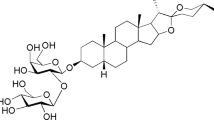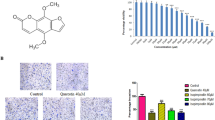Abstract
Objective
To investigate the pro-angiogenic effects of paeoniflorin (PF) in a vascular insufficiency model of zebrafish and in human umbilical vein endothelial cells (HUVECs).
Methods
In vivo, the pro-angiogenic effects of PF were tested in a vascular insufficiency model in the Tg(fli-1:EGFP)y1 transgenic zebrafish. The 24 h post fertilization (hpf) embryos were pretreated with vascular endothelial growth factor (VEGF) receptor tyrosine kinase inhibitor II (VRI) for 3 h to establish the vascular insufficiency model and then post-treated with PF for 24 h. The formation of intersegmental vessels (ISVs) was observed with a fluorescence microscope. The mRNA expression of fms-like tyrosine kinase-1 (flt-1), kinase insert domain receptor (kdr), kinase insert domain receptor like (kdrl) and von Willebrand factor (vWF) were analyzed by real-time polymerase chain reaction (PCR). In vitro, the pro-angiogenic effects of PF were observed in HUVECs in which cell proliferation, migration and tube formation were assessed.
Results
PF (6.25–100 μmol/L) could rescue VRI-induced blood vessel loss in zebrafish and PF (25–100 μmol/L), thereby restoring the mRNA expressions of flt-1, kdr, kdrl and vWF, which were down-regulated by VRI treatment. In addition, PF (0.001–0.03 μmol/L) could promote the proliferation of HUVECs while PF stimulated HUVECs migration at 1.0–10 μmol/L and tube formation at 0.3 μmol/L.
Conclusion
PF could promote angiogenesis in a vascular insufficiency model of zebrafish in vivo and in HUVECs in vitro.
Similar content being viewed by others
References
World Health Organization. The top 10 causes of death fact sheet No 310. WHO http://www.who.int/mediacentre/factsheets/fs310/en/ (May 2014, date last accessed).
Ferrara N, Kerbel RS. Angiogenesis as a therapeutic target. Nature 2005;438:967–974.
Franco CA, Liebner S, Gerhardt H. Vascular morphogenesis: a Wnt for every vessel? Curr Opin Genet Dev 2009;19:476–483.
Krupinski J, Kaluza J, Kumar P, Kumar S, Wang JM. Role of angiogenesis in patients with cerebral ischemic stroke. Stroke 1994;25:1794–1798.
Lin F, Chen BL, Wang YZ, Gao D, Song J, Kaptchuk TJ, et al. in vitro angiogenesis effect of Xuefu Zhuyu Decoction and vascular endothelial growth factor: a comparison study. Chin J Integr Med 2015. [Epub ahead of print]
Gao D, Song J, Hu J, Lin JM, Zheng LP, Cai J, et al. Angiogenesis promoting effects of Chinese herbal medicine for activating blood circulation to remove stasis on chick embryo chorio-allantoic membrane. Chin J Integr Tradit West Med (Chin) 2005;25:912–915.
Shen J, Zhu Y, Yu H, Fan ZX, Xiao F, Wu P, et al. Buyang Huanwu decoction increases angiopoietin-1 expression and promotes angiogenesis and functional outcome after focal cerebral ischemia. J Zhejiang Univ Sci B 2014;15:272–280.
Liu DZ, Xie KQ, Ji XQ, Ye Y, Jiang CL, Zhu XZ. Neuroprotective effect of paeoniflorin on cerebral ischemic rat by activating adenosine A1 receptor in a manner different from its classical agonists. Br J Pharmacol 2005;146:604–611.
Tang NY, Liu CH, Hsieh CT, Hsieh CL. The antiinflammatory effect of paeoniflorin on cerebral infarction induced by ischemia-reperfusion injury in Sprague-Dawley rats. Am J Chin Med 2010;38:51–64.
Nizamutdinova IT, Jin YC, Kim JS, Yean MH, Kang SS, Kim YS, et al. Paeonol and paeoniflorin, the main active principles of Paeonia albiflora, protect the heart from myocardial ischemia/reperfusion injury in rats. Planta Med 2008;74:14–18.
Zhang Y, Li H, Huang M, Huang M, Chu K, Xu W, et al. Paeoniflorin, a monoterpene glycoside, protects the brain from cerebral ischemic injury via inhibition of apoptosis. Am J Chin Med 2015;43:543–557.
Ji QL, Yang LN, Zhou J, Lin R, Zhang JY, Lin QQ, et al. Protective effects of paeoniflorin against cobalt chlorideinduced apoptosis of endothelial cells via HIF-1a pathway. Toxicol In Vitro 2012;26:455–461.
Ye JF, Duan HL, Yang XM, Yan WM, Zheng XX. Anti-thrombosis effect of paeoniflorin: evaluated in a photochemical reaction thrombosis model in vivo. Planta Med 2001;67:766–767.
Westerfield M, ed. The zebrafish book. A guide for the laboratory use of Zebrafish (Danio rerio). 3rd ed. Eugene, OR: University of Oregon Press; 1995:385.
Tang JY, Li S, Li ZH, Zhang ZJ, Hu G, Cheang LC, et al. Calycosin promotes angiogenesis involving estrogen receptor and mitogen-activated protein kinase (MAPK) signaling pathway in zebrafish and HUVEC. PLoS One 2010;5:e11822.
Xu H, Chen KJ. Integrative medicine: the experience from China. J Altern Compl Med 2008;14:3–7.
Li YM, Chen KJ, Zhang XW, Wang DL, Shi ZX, Zhang TZ. Effect of Xuefu Zhuyu Pill on patients with carotid atherosclerosis by colour Doppler ultrasonography. Chin J Integr Tradit West Med (Chin) 1997;17:152–154.
Yu B, Chen KJ, Mao JM, Guo JX, Lu SZ. Clinical study on effect of concentrated Xuefu Zhuyu Pill on restenosis of 43 cases coronary heart disease after intracoronary stenting. Chin J Integr Tradit West Med (Chin) 1998;18:585–587.
Xiao PG, Chen KJ. Recent advances in clinical studies of Chinese medicinal herbs. J Phytother Res 1987;1:53–57.
Zhou YW, Wang M, Ge ZY, Lin CR, Chen KJ. Effect of Xueguantong on plasma endothelin and calcitonin generelated peptide in quail atherosis model. Chin J Integr Med 1997;3:210–211.
Xu FQ, Li LZ, Xu H, Yao LF, Chen KJ, Shao NF. Effect of Xiongshao Capsule on the function of vascular endothelium of patients with cervical atherosclerosis. Chin J Integr Med 2004;10:14–18.
Chen KJ, Shi DJ, Xu H, Lu SZ, Li TC, Ke YN, et al. XS0601 reduces the incidence of restenosis: a prospective study of 335 patients undergoing percutaneous coronary intervention in China. Chin Med J 2006;119:6–13.
Wen C, Xu H, Huang QF, Chen KJ. Effects of drugs for promoting blood circulation on blood lipids and inflammatory reaction of atherosclerotic plaques in ApoE gene deficiency mice. Chin J Integr Tradit West Med (Chin) 2005;25:345–349.
Jiang YR, Yin HJ, Chen KJ. The research status of Peaoniae Radix 801. Chin J Integr Tradit West Med (Chin) 2004;24:760–763.
He YS, Wu YS, Lu EW, Li PL, Zhang CX, Wang YS, et al. A clinical and experimental study on anti-platelet aggregation effect of d-catechin. Chin J Integr Tradit West Med (Chin) 1982;2:15–18.
Li S, Dang YY, Che GO, Kwan YW, Chan SW, Leung GP, et al. VEGFR tyrosine kinase inhibitor II (VRI) induced vascular insufficiency in zebrafish as a model for studying vascular toxicity and vascular preservation. Toxicol Appl Pharmacol 2014;280:408–420.
Shibuya M, Yamaguchi S, Yamane A, Ikeda T, Tojo A, Matsushime H, et al. Nucleotide sequence and expression of a novel human receptor-type tyrosine kinase gene (flt) closely related to the fms family. Oncogene 1990;5:519–524.
Terman BI, Dougher-Vermazen M, Carrion ME, Dimitrov D, Armellino DC, Gospodarowicz D, et al. Identification of the KDR tyrosine kinase as a receptor for vascular endothelial cell growth factor. Biochem Biophys Res Commun 1992;187:1579–1586.
Habeck H, Odenthal J, Walderich B, Maischein HM, Schulte-Merker S. Analysis of a zebrafish VEGF receptor mutant reveals specific disruption of angiogenesis. Curr Biol 2002;12:1405–1412.
Ferrara N, Davis-Smyth T. The biology of vascular endothelial growth factor. Endocr Rev 1997;18:4–25.
Klagsbrun M, D’Amore PA. Vascular endothelial growth factor and its receptors. Cytokine Growth Factor Rev 1996;7:259–270.
Zachary I. Signaling mechanisms mediating vascular protective actions of vascular endothelial growth factor. Am J Physiol Cell Physiol 2001;280:C1375–C1386.
Zanetta L, Marcus SG, Vasile J, Dobryansky M, Cohen H, Eng K, et al. Expression of von Willebrand factor, an endothelial cell marker, is up-regulated by angiogenesis factors: a potential method for objective assessment of tumor angiogenesis. Int J Cancer 2000;85:281–288.
Ribatti D, Baiguera S. Phase II angiogenesis stimulators. Expert Opin Investig Drugs 2013;22:1157–1166.
Navaratna D, Guo S, Arai K, Lo EH. Mechanisms and targets for angiogenic therapy after stroke. Cell Adh Migr 2009;3:216–223.
He XH, Xing DM, Ding Y, Li Y, Xiang L, Wang W, et al. Determination of paeoniflorin in rat hippocampus by high performance liquid chromatography after intravenous administration of Paeoniae Radix extract. J Chromatogra B 2004;802:277–281.
Liu DZ, Xie KQ, Ji XQ, Ye Y, Jiang CL, Zhu XZ. Neuroprotective effect of paeoniflorin on cerebral ischemic rat by activating adenosine A1 receptor in a manner different from its classical agonists. Br J Pharmacol 2005;146:604–611.
Chen Y, Du X, Zhou Y, Zhang Y, Yang Y, Liu Z, et al. Paeoniflorin protects HUVECs from AGE-BSA-induced injury via an autophagic pathway by acting on the RAGE. Int J Clin Exp Pathol 2015;8:53–62.
Author information
Authors and Affiliations
Corresponding author
Additional information
Supported by the Science and Technology Development Fund of Macao SAR (No. 078/2011/A3 and 134/2014/A3), Research Committee of University of Macau (No. MYRG2015-00182-ICMS-QRCM), and Beijing Municipal Science and Technology Commission (No. Z141100002214011), China
Rights and permissions
About this article
Cite this article
Xin, Qq., Yang, Br., Zhou, Hf. et al. Paeoniflorin Promotes Angiogenesis in A Vascular Insufficiency Model of Zebrafish in vivo and in Human Umbilical Vein Endothelial Cells in vitro. Chin. J. Integr. Med. 24, 494–501 (2018). https://doi.org/10.1007/s11655-016-2262-2
Accepted:
Published:
Issue Date:
DOI: https://doi.org/10.1007/s11655-016-2262-2




